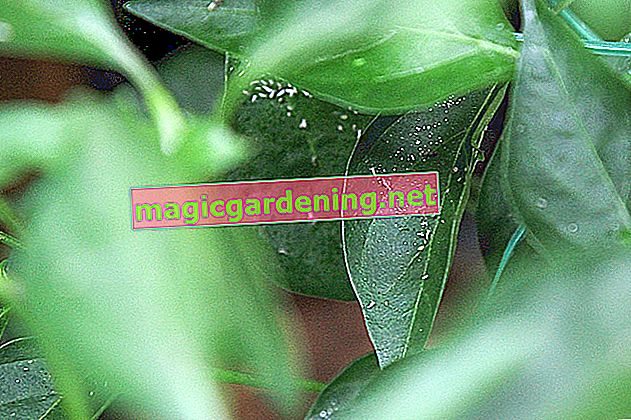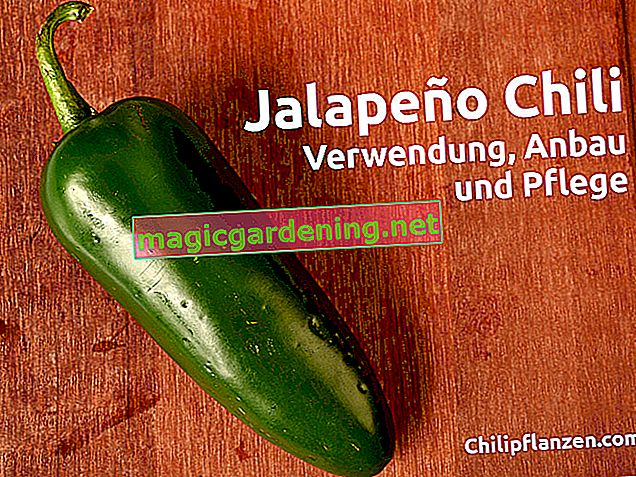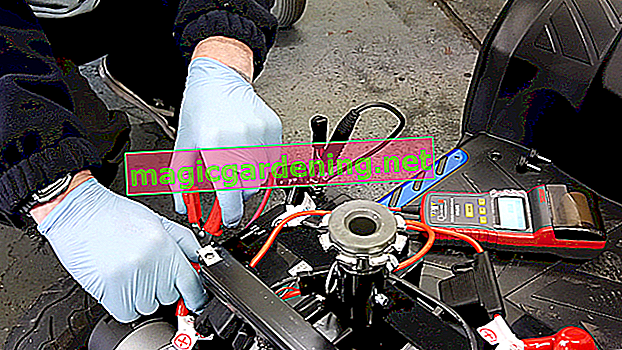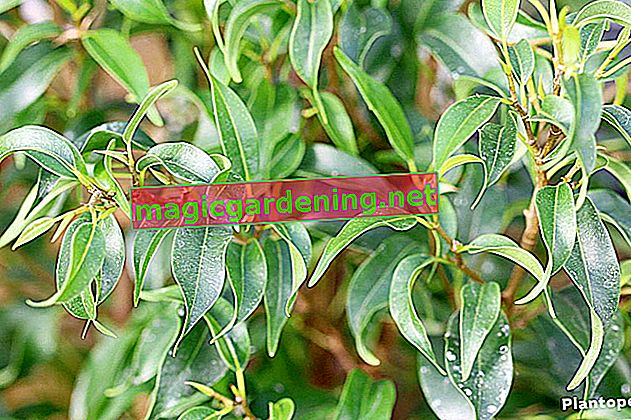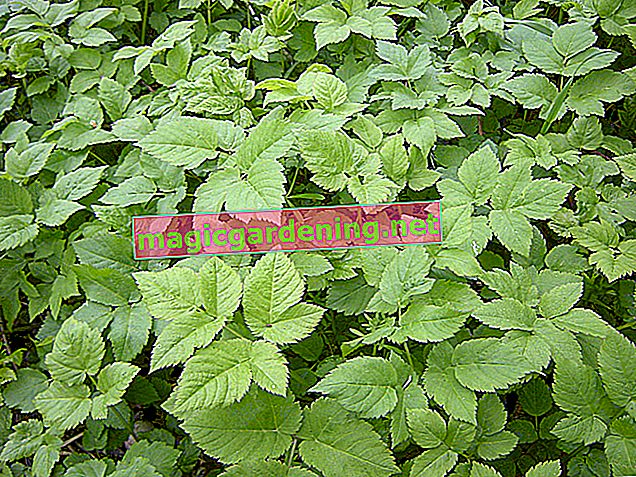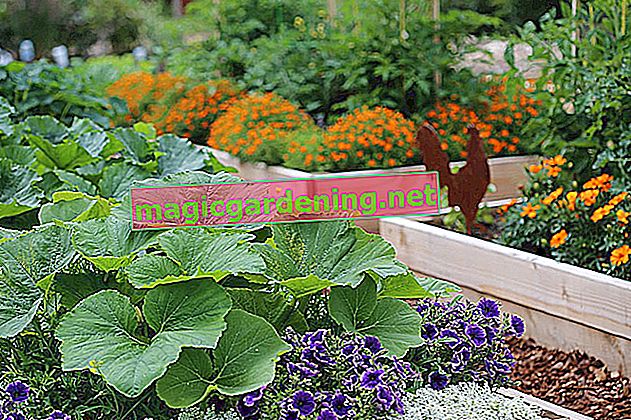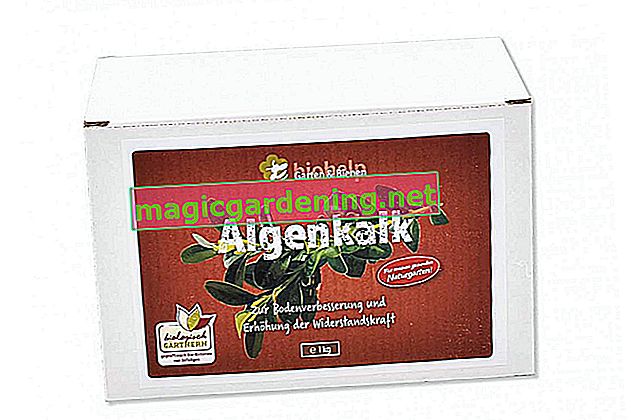
What is algae lime?
Algae lime is a slow-acting lime fertilizer (10.55 € at Amazon *) that is obtained from the coral deposits of red algae that died millions of years ago. The dolomite lime, which is often used to fertilize lawns, on the other hand, consists of sedimented mussel shells and the remains of other marine animals. Thus, algae lime is a purely biological substance that contains calcium carbonate (lime) as well as other minerals and trace elements.
also read
- Does algae lime actually help against the biggest boxwood problems?
- Does the box tree moth have natural enemies?
- The natural home of stevia
Algae lime is mainly used in organic horticulture, but also in hobby gardens, to improve the soil, for the purpose of plant protection and for fertilization. Like all types of lime, the powder neutralizes the soil acids and counteracts the gradual acidification of the soil, as happens involuntarily in the course of gardening. Algae lime is mainly used on light to medium-heavy soils.
ingredients
In contrast to other lime fertilizers, algae lime contains not only calcium carbonate (chemical formula: CaCO3), but also other minerals and trace elements essential for the nutrition of plants. The proportion of calcium carbonate, which is also known as carbonate of lime, is around 80 percent. In addition, algae lime also contains the following ingredients:
| ingredients | Average share per kilogram |
|---|---|
| Magnesium carbonate | 130 grams (13%) |
| iron | 2150 milligrams |
| boron | 416 milligrams |
| manganese | 160 milligrams |
| iodine | 40 milligrams |
| copper | 28 milligrams |
| zinc | 16 milligrams |
| molybdenum | 3 milligrams |
| cobalt | 1.1 milligrams |
| selenium | 0.16 milligrams |
Furthermore, algae lime contains aluminum, bromine, fluorine, indium, nickel, silver, titanium and tin in tiny traces, which, however, can hardly be detected and therefore neglected.
The most important difference to other lime fertilizers is the very high proportion of magnesium. In addition, algae lime acts very slowly due to the calcium carbonate it contains, as the substance is not soluble in water and is therefore only absorbed gradually.
What is calcium carbonate?
Calcium carbonate or carbonate of lime is one of the most common chemical compounds on earth. These are mainly found on sedimentary rocks and sediments that form over the course of millions of years from organic and mineral remains of mussels, corals, red algae and other marine life. The deposits are not necessarily located in the sea, because where sea water was a few million years ago is now solid land.
application

No garden can do without fertilizer, because it contains nutrients that are essential for the plants to survive. A balanced fertilization adapted to the respective soil also ensures that the plants stay healthy and can defend themselves against pathogens and pests. Many clinical pictures arise from an incorrect or insufficient composition of the soil and / or the fertilizer. A lack of calcium carbonate - i.e. lime - shows in many plants, such as boxwood, by the leaves turning brown. For this reason, algae lime in the garden is indispensable for these areas of application:
- Soil improvement : Raising a pH value that is too low and thus improving the soil structure, plants can better absorb nutrients from fertilization following liming
- Improvement of soil life : Microorganisms living in the soil are essential because they not only keep the crumb loose and permeable, but also tirelessly produce valuable humus. However, these microorganisms avoid acidic soils, which is why regular liming maintains balance and thus perfect living conditions.
- Fertilization : In addition, calcium carbonate itself is an important plant nutrient which, for example, strengthens the immune defense of the plants and thus strengthens them against harmful influences. In addition, some cultivated plants have a high need for lime and therefore benefit from fertilization in several ways.
- Plant protection : Algae lime can also be used directly as a plant protection agent to get rid of fungal or bacterial pathogens or animal pests in the garden.
However, the use of algae lime and other lime fertilizers does not always make sense. When and under what conditions you should lime the garden, you will find out in the following sections.
Mode of action
Over time, the pH of the garden soil will naturally drop into the acidic range. There are many reasons for this, including, for example, the continuous washing out of the calcium in the earth through rain and garden irrigation. But also harvesting vegetables, clearing the beds in autumn and mowing the lawn can lower the pH value.
As a result, the plants absorb existing and added nutrients more and more poorly, so that over time there may be a nutrient deficiency - even though there are actually enough nutrients in the right composition in the soil. At an acidic pH, however, these are found too firmly on the soil particles and are therefore no longer available for the plants. Lime fertilization neutralizes the soil, which promotes the uptake of nutrients by the garden plants. Algae lime has proven to be an effective aid, especially on acidic sandy soils.
The soil quality improved by liming is shown by features such as these:
- improved soil structure
- improved activity of soil-living microorganisms
- Water can be better stored in the soil
- The substrate contains more air and is therefore looser
- Heavy metals in the soil are bound by lime
All of these benefits result in plants growing better and healthier.
Tips
However, not all plant species can tolerate lime fertilization. Some - such as rhododendrons, azaleas and heather plants such as heather - are extremely sensitive to lime and love an acidic pH value. For this reason, you should also not lime camellias, hydrangeas or summer heather.
When does fertilization with algae lime make sense?
In the garden, algae lime can be used very well in the following areas:
- Container plants : as a preventive fertilization measure against deficiency diseases, which can be seen, for example, when the leaves turn light green (called chlorosis)
- Flowering plants : after liming, they often bloom particularly beautifully and for a long time, as they can now better absorb the phosphorus, which is so important for flower formation
- Potato cultivation : Potatoes germinate better on a limed cultivation area and are more resistant to many pests, for example nematodes (roundworms)
- Vegetable cultivation : Due to the improved absorption of nutrients, useful plants grow better in limed soil, and dusting the plants with lime powder helps against many diseases and pests
This section of text explains when the use of algae lime is advisable in the garden and how you can identify the need for lime.
Lack of lime in the soil
A lack of lime in the soil is particularly noticeable in the vegetable patch. Typical signs are for example:
- Stunted growth
- pale leaves, yellow discolored young leaves
- withered shoot tips
- Flower end rot (in tomatoes)
- brown spots or spots on fruit (especially apples)
The growth disturbances show up primarily through stunted, slow growth and through the characteristic signs of malnutrition, which results from the poor availability of nutrients in the soil. If you suspect a calcium deficiency, a simple pH value from the pharmacy quickly creates certainty so that you can initiate the appropriate countermeasures as soon as possible.
Which plants indicate a lack of lime
So-called pointer plants are plants that clearly show the condition and composition of the soil even without chemical soil analysis. Grow intensified species like
- Hasenklee
- Little sorrel
- Field horsetail
- Sand pansy
- Three-leaved speedwell
- Farm mustard
- or moss
In your garden, the lime content of the soil is too low and appropriate countermeasures - namely the liming of the same - are urgently required. The plants mentioned feel very comfortable in acidic soil and therefore mark a garden soil with a pH value that is too low.
Lime-loving plants
Many of the typical garden plants love lime and need calcareous soil in order to grow and thrive. The following species, for example, benefit from regular liming:

- Lilac (syringa)
- Lavender (Lavandula)
- Christmas rose (Helleborus niger)
- Boxwood (Buxus)
- Judas tree (Cercis siliquastrum)
- Wig bush (cotinus coggygria)
- Common ash (Fraxinus excelsior)
- Japanese or tulip rose (Eustoma lisianthus)
- Sloe or blackthorn (Prunus spinosa)
- Sea buckthorn (Hippophae rhamnoides)
- Daisies (Leucanthemum)
- many herbs such as wild garlic, chives or parsley
Furthermore, the addition of lime is often essential for lawn care, especially since the pH value of the soil drops again and again through regular lawn mowing. Moss and wood sorrel in the lawn are sure signs that you should reach for the algae lime.
However, there are also many plants that are very sensitive to lime and therefore should not be limed. When buying, pay attention to the relevant information on the plant label and do not place these plants in the immediate vicinity of lime-loving plants.
When should lime fertilization be omitted?
"Lime makes rich fathers and poor sons" (peasant wisdom)
However, in view of all the advantages described, you should not supply your garden with algae lime straight away, because like so much calcium carbonate used in excess has negative effects. Too much lime in the soil leaches it out in the long term, so you should definitely adhere to the manufacturer's exact dosage recommendations. In addition, have a soil test carried out regularly - preferably about every two years - in a specialized laboratory in order to find out the exact composition and pH value of the crumb. Together with the chemical analysis, the laboratory also provides you with specific fertilization recommendations so that there is no over-fertilization.
You can have the soil analysis carried out in a state or private laboratory, where you take the samples yourself and send them to the selected provider together with the application form (which can be printed out on the internet). When taking the soil samples, follow the instructions exactly so that measurement errors do not occur.
How to do a pH test yourself

However, you can easily carry out a simple pH test yourself:
- Buy pH test sticks at the pharmacy or garden center.
- Take a soil sample from ten centimeters deep.
- Crumble the sample in a plastic bucket.
- Add distilled water in a 1: 1 ratio.
- Stir the sample well.
- Insert the test stick.
- After waiting one minute, read the test result.
Alternatively, you can also use indicator paper, which shows the pH value of the soil sample based on its color. A value between 6.5 and 8 is optimal, below this the soil is too acidic and should be limed. A value above 8, however, speaks against liming, because in this case the soil is already too alkaline.
Use and dosage
There are often specific dosage recommendations on the packaging of most types of algae lime, but these are mostly general quantities. These do not relate to the specific garden soil - each type of soil requires different amounts of lime - and are mostly based on the recommendations for “healthy” soil. This means that the recommendations are only suitable for maintenance liming, as experts call acidification preventive liming.
dosage
For a so-called recovery liming, ie for liming an already over-acidic soil, completely different guide values are necessary. The following table shows you which amounts of algae lime you need for which soil and pH values.
| Soil type | PH value | Algae lime in grams per square meter |
|---|---|---|
| Light ground | less than 5.3 | 200 |
| Light ground | between 5.3 and 5.7 | 120 to 180 |
| Medium heavy soil | less than 5.7 | 300 to 400 |
| Medium heavy soil | between 5.7 and 6.5 | 180 to 250 |
| Heavy ground | less than 6.3 | 400 |
| Heavy ground | between 6.3 and 7.0 | 250 to 350 |
As you can see from the table, a heavy clay soil needs about twice as much lime as a light sandy soil. You should therefore generally plan higher quantities for heavy soils than for light ones - this applies to both maintenance and recovery liming.
How and when is best to fertilize with algae lime
The best period for liming is either early spring - before the first shoots start to rain - or autumn. The reason for this is the fact that algae lime takes a long time to take effect. In addition, the soil should be supplied with the effect at least four weeks before the first fertilization, otherwise the nutrients will not be properly absorbed by the plants. Basically, it is first limed and then fertilized. Only in exceptional cases - for example when you are creating a new lawn or a vegetable patch - do you apply algae lime and (organic) fertilizer at the same time to optimize the starting conditions. The soil is loosened before liming so that the powder can penetrate better. Use a spreader or a suitable hand tool for spreading,to ensure an even distribution of the material. Do not work in windy and / or rainy weather.
What advantages does algae lime have over other lime fertilizers?

Basically, the highly praised algae lime has no significant advantages over other types of lime. Calcium carbonate is calcium carbonate, regardless of the source. The effectiveness is always the same. Only the 20 percent additional minerals and trace elements that other lime fertilizers do not have to be emphasized. In particular, the high proportion of magnesium should be emphasized. However, you can also administer these nutrients with normal fertilization, so that they alone do not justify the higher price of algae lime. Especially since the proportion of calcium carbonate is significantly lower due to the admixtures per 100 grams and you therefore need about 20 percent more algae lime per square meter of surface compared to other calcium fertilizers.
background
What does lime do in the soil?
Lime is supposed to deacidify the soil and raise its pH value. Most garden plants need a neutral to slightly alkaline pH value, which is regularly reduced by many gardening activities such as mowing the lawn, raking leaves and harvesting the vegetable patch. In addition, the activities of soil organisms are strongly influenced by the acidity of the soil and its physical properties, which is why the addition of lime improves the soil structure. The calcium ions combine humus and clay particles in the earth to form more stable, larger crumbs and ensure that plants can better absorb water and nutrients.Algae lime against pests and plant diseases
Fungal diseases in the garden are annoying because they threaten the growth of the plants and the harvest, and they are often fatal for the plants affected. With the help of fine, powdery algae lime, however, you can put an end to the fungal pathogens: Dust the leaves and shoots of the green plants thinly with the powder, then diseases such as powdery mildew or scab have no chance. However, only apply the algae lime thinly so as not to adversely affect the respiration and photosynthesis of the plants. At best, use a special powder atomizer to ensure even distribution.
Digression
Tinker powder atomizer yourself
If you don't have a powder atomizer, a PET bottle will do the same. You poke a hole in the plastic lid with a needle. Pour the algae lime powder into the bottle, screw on the lid and atomize the powder by pressing lightly on the container.Algae lime against pests
In the same way as described, algae lime helps against many annoying garden pests such as the earth flea, the Colorado beetle or the leek moth. However, the powder seems to be particularly effective against the dreaded boxwood moth, whose voracious caterpillars have been threatening entire boxwood plantations for several years. The effect is particularly great here when the caterpillars cannot even settle in the box: If you dust box bushes regularly with algae lime from spring to autumn, then no caterpillars can develop there. Start the procedure as soon as you see the first butterflies at the latest.
The following video shows very clearly how this works:
YoutubeWhite painting on fruit trees
A lime or white coating of fruit tree trunks is an effective method to protect the sensitive bark of still young trees from frost cracks. In addition, such a coating prevents annoying game bites and associated damage, especially in natural gardens and orchards. In addition, the algae lime in the bark of the woody plants kills wintering pests, so that the plague that is expected in the following year is less than feared.
Mix and apply the lime coating
You can easily mix and apply a white coating yourself. However, do not use quicklime, even if this is suggested in some recipes. This is unslaked lime, which can cause severe burns to the skin, mucous membranes and the respiratory tract. It is better to use carbonate of lime such as algae lime.
And this is how you mix and use a white paint:
- Mix ten liters of tap water with one and a half kilograms of algae lime.
- Add half a kilogram of wallpaper paste (without additives!).
- Stir the mixture thoroughly until all of the components have combined.
- Now work the bark of the trees carefully with a wire brush.
- Remove moss, lichen and loose pieces of bark.
- Do not damage the bark!
- Brush the trunk and the leading branches with a thick brush.
- Work from the bottom up.
- Young shoots are not painted.
- Let the first layer dry and paint over the wood one more time.
The ideal time for such a coat of paint is late autumn, although another one may be necessary after damp and rainy weather: the lime coat is not waterproof and is washed off by rain.

Ecological problem
Since 2012, algae lime produced in the EU has only been allowed to be extracted from fossil deposits. The reason for this regulation was the fact that the material had previously often been extracted from living red algae banks (the so-called “Maërl banks”) with the help of vacuum-cleaner boats. As a result, the algae banks and their ecosystems together with the other marine life living there and from them were permanently destroyed. In contrast, the mining of fossil deposits is considered ecologically harmless.
Calcareous algae of the Lithotamnium calcareum species grow extremely slowly, so that the construction of a limestone deposit takes a lot of time - in comparison to the way peat forms in a raised bog. But this is not the only reason why the extraction of algae lime from living banks is problematic: The Maërl banks are home to many rare fish and other marine life, so that when the algae disappear, these water dwellers also die.
Although these algae banks have been protected across the EU since 2012, retailers can still sell algae lime from living banks. These products come from countries outside the EU and are therefore subject to different laws. When buying algae lime, make sure that it comes from fossil deposits. Inquire at specialist retailers where the product you want comes from and where it was broken down.
frequently asked Questions
Is algae lime poisonous?
Algae lime is neither poisonous for humans nor for animals, so you can easily touch it with your hand. Nevertheless, you should wear a face mask and protective goggles when spreading, because the fine dust irritates the mucous membranes. This also applies to pets. In addition, do not lime on very windy days and make sure that the wind is always behind you during the lime. Not only do the powdery varieties generate a lot of dust, but also the granules.
Does algae lime also help against moss?
Since moss basically indicates an over-acidic soil, a recovery liming is indicated. With moss in the lawn, first scarify the area and then apply the recommended amount of algae lime according to the pH value and the type of soil.
Is algae lime also suitable for roses?
Roses prefer a neutral to slightly acidic soil, which is why you should only lime the bed if it is over-acidic. However, dusting the bushes with algae lime or rock flour (€ 14.95 at Amazon *) helps against all kinds of diseases and pests, such as the unsightly fungal disease rose rust.
What are the differences between garden lime and algae lime?
Algae lime is always calcium carbonate obtained from (fossil) red algae, while garden lime (€ 10.55 at Amazon *) comes from other sources. In addition, algae lime has natural additions of minerals and trace elements of around 20 percent that normal garden lime does not have or that are artificially added to it.
Tips
A vegetable garden has an optimal pH value of 7, which is why you need between 250 and 500 grams per square meter for liming with algae lime, depending on the nature of the soil. For flower beds and lawns, the pH value may be 6.5, which is why lower amounts are necessary here.


